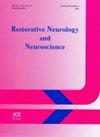一例罕见的伴有颅内出血及弥漫性脑桥病变的舌性肌阵挛
IF 1.6
4区 医学
Q4 NEUROSCIENCES
引用次数: 0
摘要
我们描述一个35岁的男人,谁遭受了严重的脑室内出血,并被承认在我们的三级诊所重症监护室。事件发生两周后,在重症监护室,神经学检查发现持续的,波动的,有节奏的,肌阵挛的舌头运动。通过CT扫描、MRI和脑电图的诊断评估显示,弥漫性脑干病变以及多发胼胝体病变是相当重要的潜在病因。本病例报告试图更新目前对舌肌阵挛罕见现象的研究。本文章由计算机程序翻译,如有差异,请以英文原文为准。
A rare case of undulatory rhythmic lingual myoclonus in a patient with intracranial hemorrhage and diffuse pontine lesion
We describe a 35-year-old man, who suffered a severe intraventricular hemorrhage and was admitted to the intensive care unit of our tertiary clinic. Two weeks after the incident, while in ICU, a neurological examination revealed persistent, undulating, rhythmic, myoclonic tongue movements. The diagnostic evaluation via CT scan, MRI and EEGs elicited a diffuse brainstem lesion as well as multiple corpus callosum lesions as a considerable underlying etiology. This case presentation attempts to update the current investigation of the rare phenomenon of lingual myoclonus.
求助全文
通过发布文献求助,成功后即可免费获取论文全文。
去求助
来源期刊
CiteScore
5.40
自引率
3.60%
发文量
22
审稿时长
>12 weeks
期刊介绍:
This interdisciplinary journal publishes papers relating to the plasticity and response of the nervous system to accidental or experimental injuries and their interventions, transplantation, neurodegenerative disorders and experimental strategies to improve regeneration or functional recovery and rehabilitation. Experimental and clinical research papers adopting fresh conceptual approaches are encouraged. The overriding criteria for publication are novelty, significant experimental or clinical relevance and interest to a multidisciplinary audience. Experiments on un-anesthetized animals should conform with the standards for the use of laboratory animals as established by the Institute of Laboratory Animal Resources, US National Academy of Sciences. Experiments in which paralytic agents are used must be justified. Patient identity should be concealed. All manuscripts are sent out for blind peer review to editorial board members or outside reviewers. Restorative Neurology and Neuroscience is a member of Neuroscience Peer Review Consortium.

 求助内容:
求助内容: 应助结果提醒方式:
应助结果提醒方式:


